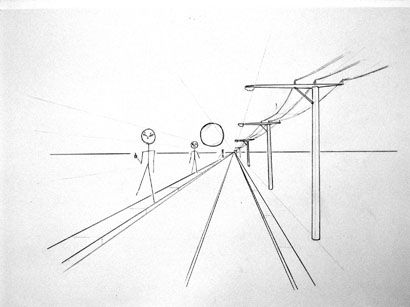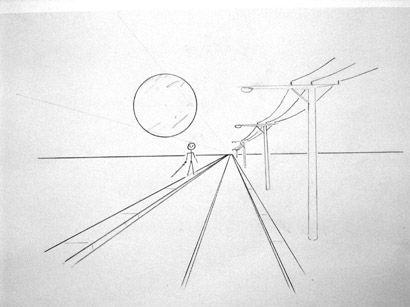The Moon Problem
LCF commented in my June 27 post:
This is definitely a valid method to capture a photograph with an oversized lunar body, but I feel that it’s blatant cheating. There are also some potential problem that the photographer needs to watch out for.
The moon and scenery must not occupy the same area on the film, else the resulting (double) image would be a moon shining through the ghost of the Alps/ the Parthenon/ the Kek Lok Si.
As a consequence, the photographer cannot make the moon rise out from behind the Alps/Parthenon/ Kek Lok Si without some serious tricks with Photoshop.
I would propose an alternative method that is 'real', but requires some research as to the times of moonrise/set.
In the example given below, the photographer is in a bleak, monochromatic desert preparing to capture some depressing images of a moonrise over a white landscape. There is a straight road that seems to stretch on to infinity, with evenly spaced street lamps along one side of the road. Power and communication lines run along the tops of the lamp posts.

Click to view large size image
Along the road are 3 men. The one nearest to the photographer looks to be a super-aggressive character. Look, he already has his middle finger waving at the photographer. The second man looks constipated, and the third man is too far away in the distance to figure out the long object in his hand. My conjecture is that they are all miserable because there were no women in the scene.
The moon has just risen over the horizon. Using his SLR camera, the photographer zooms to 105mm (3x zoom) and snaps this first image. The first man is still rude as ever, the second man still needs a laxative suppository, and the third man is not well defined.
The photographer removes his 105mm lens, and snaps on a massive 350mm lens for 10x magnification. He then snaps the second image. As a direct consequence of the magnification, the man, the moon and the streetlamps are all magnified.
It turns out that the third man is holding a Japanese katana. The second man is not in the picture- while the photographer changed lenses, the first man turned around and gave the constipated man a rude finger gesture. Annoyed, the constipated man walks over to the first man and promptly kills him.

Click to view large size image
Referring to the second image, we see that the third man in the distance had been magnified to a more normal size. However, the moon had also been magnified, and now it looks like a damn big sphere in the sky.
In conclusion, it is easy to make the moon look like a damn big sphere in the sky. Use a huge telephoto lens; zoom in on a distant object to make it look like it’s quite nearby, and the moon will look like a damn big sphere in the sky. Refer to the pictures here. I’m pretty sure the first image is a very far shot of the city using a telephoto lens assembly on a double dose of Viagra.
Epilogue:
When the photographer got the photos printed, he brought them to his magazine’s press office. There, he told his editor and other journalists this:
To which the editor simply said, “Bullshit. Talk cock lah, you.”
Endnote:
The 2 images were drawn with assistance from a straight edge and a compass (for the ‘large’ moon). A reasonable degree of accuracy was achieved by overlaying the paper for the magnified image over the wide-angle drawing, thus using the same vanishing point and horizon.
In principle, the magnification was done by considering the wide-angle image using polar coordinates with the vanishing point as the pole. Magnification was done by simply multiplying the radial distances by a certain factor while keeping the same angular displacements (relative to the horizon).
Cite this article as:
Tan Yee Wei(2005), "The Moon Problem", from "Snippets of This and That"
http://tanyeewei.blogspot.com/2005/06/moon-problem.html
In regard to the "big moon" pictures shown in magazines/books/BBC that you were referring to, sometimes they [are taken] in two separate shots. The fist one, with a telephoto aim at the moon. The second shot (without advancing the film after the first shot) aiming at the scenery. Then, you can get nice night scenery with big moon as background.
This is definitely a valid method to capture a photograph with an oversized lunar body, but I feel that it’s blatant cheating. There are also some potential problem that the photographer needs to watch out for.
The moon and scenery must not occupy the same area on the film, else the resulting (double) image would be a moon shining through the ghost of the Alps/ the Parthenon/ the Kek Lok Si.
As a consequence, the photographer cannot make the moon rise out from behind the Alps/Parthenon/ Kek Lok Si without some serious tricks with Photoshop.
I would propose an alternative method that is 'real', but requires some research as to the times of moonrise/set.
In the example given below, the photographer is in a bleak, monochromatic desert preparing to capture some depressing images of a moonrise over a white landscape. There is a straight road that seems to stretch on to infinity, with evenly spaced street lamps along one side of the road. Power and communication lines run along the tops of the lamp posts.

Click to view large size image
Along the road are 3 men. The one nearest to the photographer looks to be a super-aggressive character. Look, he already has his middle finger waving at the photographer. The second man looks constipated, and the third man is too far away in the distance to figure out the long object in his hand. My conjecture is that they are all miserable because there were no women in the scene.
The moon has just risen over the horizon. Using his SLR camera, the photographer zooms to 105mm (3x zoom) and snaps this first image. The first man is still rude as ever, the second man still needs a laxative suppository, and the third man is not well defined.
The photographer removes his 105mm lens, and snaps on a massive 350mm lens for 10x magnification. He then snaps the second image. As a direct consequence of the magnification, the man, the moon and the streetlamps are all magnified.
It turns out that the third man is holding a Japanese katana. The second man is not in the picture- while the photographer changed lenses, the first man turned around and gave the constipated man a rude finger gesture. Annoyed, the constipated man walks over to the first man and promptly kills him.

Click to view large size image
Referring to the second image, we see that the third man in the distance had been magnified to a more normal size. However, the moon had also been magnified, and now it looks like a damn big sphere in the sky.
In conclusion, it is easy to make the moon look like a damn big sphere in the sky. Use a huge telephoto lens; zoom in on a distant object to make it look like it’s quite nearby, and the moon will look like a damn big sphere in the sky. Refer to the pictures here. I’m pretty sure the first image is a very far shot of the city using a telephoto lens assembly on a double dose of Viagra.
Epilogue:
When the photographer got the photos printed, he brought them to his magazine’s press office. There, he told his editor and other journalists this:
You know, that day I went into the Siberian wasteland to take some photos of the moonrise. Then, all of a sudden, a massive pink spacecraft came right up to the moon and stuck a long tube-like thingy into it. It seemed to be pumping stuff into the moon, because I saw the moon inflate like a balloon before a birthday party. This happened while I was changing the lenses on my camera, and I couldn’t take any photos.
Anyway, the thing inflated the moon more and more…until it was three times its original size. Wah lau…cau ci bai…I was so shocked you know. Suddenly the moon ruptured, and beige coloured fat-free Caesar dressing spewed all over the landscape. It was very horrible.
Out of nowhere, several tanker trucks appeared, and with some sort of vacuum hose, sucked up as much of the salad dressing as they could, and then as quickly as they had materialised, they disappeared into the desert air.
I tell you…something is seriously wrong.
To which the editor simply said, “Bullshit. Talk cock lah, you.”
Endnote:
The 2 images were drawn with assistance from a straight edge and a compass (for the ‘large’ moon). A reasonable degree of accuracy was achieved by overlaying the paper for the magnified image over the wide-angle drawing, thus using the same vanishing point and horizon.
In principle, the magnification was done by considering the wide-angle image using polar coordinates with the vanishing point as the pole. Magnification was done by simply multiplying the radial distances by a certain factor while keeping the same angular displacements (relative to the horizon).
Cite this article as:
Tan Yee Wei(2005), "The Moon Problem", from "Snippets of This and That"
http://tanyeewei.blogspot.com/2005/06/moon-problem.html

<< Home